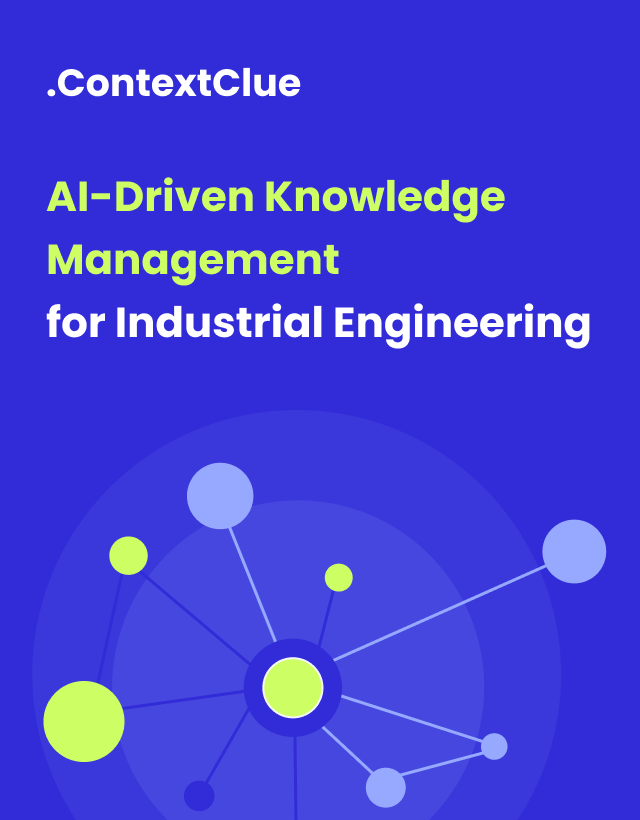
October 14, 2025
Let’s get real about enterprise AI: It’s not a “Super Brain,” it’s math with rules
Author:

Senior Account Manager
Reading time:
9 minutes
There’s a persistent belief that Artificial Intelligence is a kind of “super brain” – an all-knowing system capable of instantly learning everything and delivering flawless results.
This myth has fueled unrealistic expectations in enterprise environments, where leaders often anticipate rapid, fully automated transformation.
But in practice, implementing AI in a business context is not about activating an omniscient system. It’s about building, testing, and continuously refining a mathematical model – one that depends on structured data, domain expertise, and constant human input.

Listen summary of this article:

Below, we unpack the most common misconceptions that derail enterprise AI projects and show when and how AI actually delivers value.
The nature of AI hype in 2025
When everything is labeled ‘AI,’ expectations rise and projects crash. The term now covers everything from predictive algorithms to chatbots, creating LinkedIn fairy tales that rarely survive first contact with real-world implementation.
Executives read headlines like “AI optimizes logistics” or “AI handles pricing” and imagine autonomous systems delivering instant ROI. What they actually get are statistical or mathematical models that need:
- months of data preparation,
- explicit business rules,
- constant human supervision and often only deliver incremental, not revolutionary, gains.
This gap between expectation and reality wastes budgets, burns teams out, and makes leaders skeptical of tools that could genuinely help if used correctly.
Most so-called “AI” systems fall into two distinct categories. Confusing them is the root of 90% of disappointment.
- Generative AI (ChatGPT, Claude, Gemini) – great for text/image generation; fails at precision, reasoning, or context.
- Specialized AI (Forecasting, Optimization, Recommenders) – great for structure and data; fails at novelty, messy data, or ambiguity.
Before saying “AI will optimize operations,” ask which type you’re actually talking about.
The answer determines whether you’ll need three weeks or three years and whether success depends on prompts or on clean, well-modeled data.
The Three-Month MVP Trap: Discovery Isn’t Delivery
One of the biggest misunderstandings happens right at the start: the expectation that a complete AI MVP can be built in just a few months.
But those first three or four months are rarely enough to produce tangible automation results.
Instead, that time is usually spent gathering data, cleaning it, and understanding the underlying business logic.
- Unrealistic deadlines
Some organizations expect a fully functional AI model in weeks – assuming it works like consumer tools such as ChatGPT. In reality, enterprise AI requires time for data preparation, domain modeling, and testing before it can even start generating useful insights. - The “paper to algorithm” fails
A recurring misconception is that existing documentation or spreadsheets can simply be “fed” into an algorithm to produce results. But unstructured data, human reasoning, and undocumented rules cannot be instantly transformed into machine logic.
When it can work:
A short MVP timeline is possible only when the problem is tightly scoped, the data is clean and digitized, and the process is well understood.
In such cases, automation of repetitive calculations or detection of simple patterns can be delivered within weeks – but not complex decision-making.
The Domain Knowledge Gap: What’s in People’s Heads?
Technology is rarely the bottleneck, but missing domain knowledge is. In most companies, the expertise needed to make AI effective exists mainly in people’s heads, not in structured systems.
In one project example, an algorithm trained on operational data initially performed well on measurable parameters but failed on edge cases – situations that only experienced employees knew how to handle. Those unwritten rules had never been documented and surfaced only when the model made “incorrect” decisions.
For instance: in an optimization task involving scheduling and resource allocation, the model could distribute tasks efficiently based on capacity and timing. However, it consistently made decisions that violated informal but crucial business rules – like avoiding certain task combinations due to safety, client preference, or regulatory nuances that had never been captured in the dataset. These exceptions were obvious to experienced staff but invisible to the algorithm until explicitly encoded as rules.
AI can only replicate what has been explicitly defined or captured. Tacit human knowledge – intuition, priorities, exceptions – must first be translated into structured logic before it can be automated.
Here’s the uncomfortable truth: the people with the knowledge you need are often reluctant to share it, fearing that your system might make them obsolete.
The Data Delusion: “We Have Data” (Until You Look Closer)
Many organizations assume they’re ready for AI because “we already have data.”
But data volume does not equal data readiness.
- Quantity: AI models typically require thousands of high-quality examples, not a few dozen.
- Format: Raw documents, reports, or recordings are not machine-readable data. They must be transformed into structured, labeled datasets first.
- Quality: Even large datasets may be outdated, reflecting old prices, conditions, or workflows. In such cases, the model learns logic that no longer applies to the business.
The time spent cleaning and restructuring data is often far greater than expected, but it’s also the phase that determines whether the project succeeds or fails.
Here’s what unrealistic conversations sound like on both sides of the table.
Vendor’s talking:
| What The Vendor Says | What It Actually Means |
|---|---|
| “AI will handle this automatically within 3 months” | We’re underestimating by a factor of 3-5 |
| “You don’t need to worry about data quality, AI figures it out” | We haven’t looked at your actual data yet |
| “This is just like ChatGPT but for your business” | We don’t understand the difference between LLMs and specialized systems |
| “90% automation is standard with our AI solution” | We’re quoting the absolute best case that happened once |
| “We’ve done this hundreds of times, it’s straightforward” | We’ve sold this hundreds of times; delivered successfully maybe 12 times |
Client’s talking:
| What The Client Says | What It Actually Means |
|---|---|
| “We have lots of data” | We have Excel files we’ve never actually examined |
| “Our process is pretty standard” | We think it’s standard, but we’ve never documented it |
| “We just need AI to do what our expert does” | We have no idea how to articulate what our expert knows |
| “ChatGPT works great, so this should be easy” | We fundamentally misunderstand what we’re asking for |
When both sides are using “AI” as a magic word, disaster is inevitable.
The Hard Truth: AI Isn’t Magic, It’s Math
Unlike generative AI tools that produce text or images, enterprise systems are built on mathematical models designed for optimization, forecasting, or classification.
They don’t “learn” like humans, they calculate outcomes based on rules and data.
- Iterative development: Real-world models improve through cycles of testing, feedback, and recalibration. Each new constraint or rule can shift results dramatically, sometimes improving accuracy and sometimes reducing it until tuned again.
- Hybrid logic: Some rules are fixed (“if X, then Y”), while others are dynamically computed based on current data. The right balance between both determines stability and scalability.
AI in business is closer to engineering than to creativity. It’s a tool for mathematical reasoning, not a self-aware problem-solver.
The Mindset Shift: From Automation to Augmentation
Eventually, most AI projects reach the same conclusion: the goal is not full replacement, but augmentation.
When a model reaches maturity, it often acts as a decision-support layer, handling calculations, generating recommendations, or pre-filling solutions that a human expert then validates and adjusts.
This partnership approach dramatically increases speed and consistency while preserving human judgment where it matters most. The best results come when experts and algorithms collaborate.
So, here’s what actually happens in most successful AI projects:

- What was promised: “AI will handle pricing automatically!”
- What was delivered: “The system generates a starting point. Your pricing expert reviews it and makes adjustments. This saves them about 2 hours per day.”

- What was promised: “AI optimizes packing with one click!”
- What was delivered: “The algorithm suggests a packing arrangement. Expert X reviews it, spots the three things it got wrong, fixes them in 5 minutes instead of spending 3 hours planning from scratch.”

- What was promised: “AI replaces your support team!”
- What was delivered: “Chatbot handles 40% of simple questions. Complex issues still go to humans. Team size is reduced by one person.”

This is still valuable. Saving 2 hours a day adds up, and it is ROI.
When AI Actually Works: The Real Success Conditions
Enterprise AI succeeds when several conditions align:
- Clear, narrowly defined use case: The goal must be specific and measurable, not abstract (“make operations smarter”).
- Reliable, structured data: Data should be consistent, up-to-date, and sufficiently large.
- Accessible domain expertise: Subject-matter experts must be involved in translating tacit knowledge into logic.
- Iterative process mindset: Expect adjustment, validation, and learning cycles, not instant perfection.
- Business-driven alignment: The project must solve a real operational problem, not just demonstrate technical potential.
When these factors are in place, AI delivers exceptional results – not by replacing humans, but by extending their reach and amplifying their impact.
The bottom line: Be specific
A year ago, many of today’s so-called ‘AI experts’ were business coaches, consultants, or sales trainers. Now they post confidently about model reasoning and the future of artificial general intelligence, despite never training a model, cleaning data, or watching a real AI project collapse under the weight of undocumented business logic.
And – this isn’t gatekeeping – when people with no technical grounding make sweeping claims about what “AI” can do, they fuel the hype-disappointment cycle.
They see ChatGPT generate a coherent paragraph and conclude it can run a company. It can’t. Different tools, different capabilities, different rules, but the same old story.
Remember blockchain? Every problem was a “perfect use case.” Except 95% of those problems were better solved with a regular database.
Remember the metaverse? Every brand needed a strategy. Except nobody wanted to attend virtual meetings wearing a headset.
We’re in that same cycle again with AI. The hype is peaking, and disillusionment is next.
What actually works is far less glamorous: being boringly specific.
Not “AI revolutionized customer service,” but “a ChatGPT-based assistant now resolves 40% of routine queries.”
Not “AI optimized operations,” but “a scheduling algorithm saves our logistics team 90 minutes a day.”
Specificity kills mythology. It signals competence, sets realistic expectations, and rebuilds credibility.
Category:






